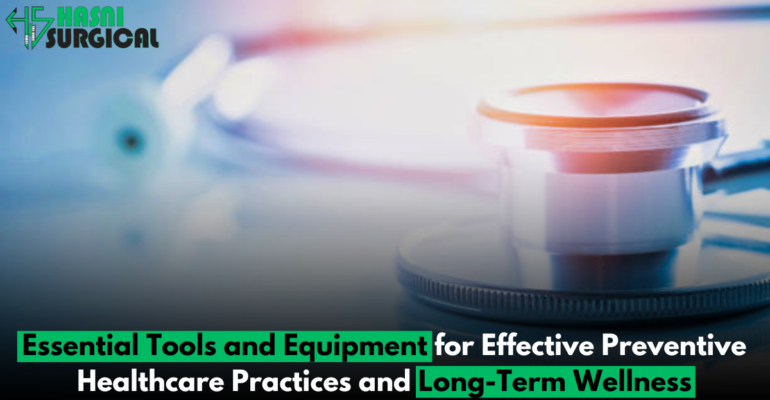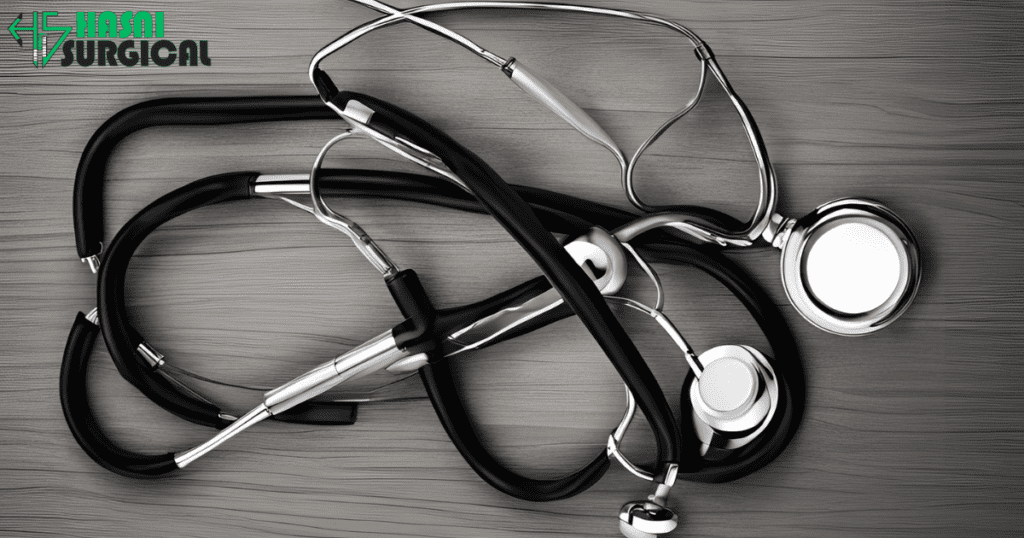9 Essential Equipment for Powerful Preventive Healthcare Practices
December 20, 2024 2024-12-20 12:269 Essential Equipment for Powerful Preventive Healthcare Practices

9 Essential Equipment for Powerful Preventive Healthcare Practices
Preventive healthcare is the basic necessity for life extended long and healthy. This stresses the early detection and follow-up regular checks that prevent even small possible diseases from reaching extreme phases.
Tools used for preventive healthcare include instruments like a stethoscope, sphygmomanometer or a blood pressure monitor, dental equipment, etc., through which a person along with health professionals can work toward keeping healthy regularly and in perfect health.
Role of Preventive Healthcare
Preventive care tools reduce the risk of getting any diseases through check-ups, immunization, and lifestyle modification. Underlying medical tools used for tracking, monitoring, and detecting early warning signs about potential health issues form its base. Such preventive care tools equip patients with control over their own health and assist healthcare professionals to implement interventions at the appropriate time.

1. Stethoscopes: The Symbol of Preventive Healthcare Medicine
A stethoscope is probably one of the most common preventive healthcare instruments. The Preventive care tools allows listening to the internal sounds of a body, such as heartbeats, lung sounds, and blood flow.
Main Uses:
1) Cardiovascular system: Detects abnormal rhythms or murmurs.
2) Respiration: Checks for wheezing, crackling, or any other manifestation of lung infection.
3) Maternal and pediatric care: monitoring foetal heartbeats or observing children’s breathing systems.
High-tech electronic stethoscopes amplify the sounds and provide recording and visual waveform analysis with greater accuracy and ease in the diagnosis of conditions.

2. Blood Pressure Monitors: The Silent Killers in healthcare practices
High blood pressure, or hypertension, is the “silent killer” because it does not give any symptoms until the disease has caused extreme damage. Keeping cardiovascular health under control calls for constant monitoring using a blood pressure monitor.
Types of Blood Pressure Monitors:
1) Manual (Aneroid): These are mostly used in clinical practice and demand training to take an accurate reading.
2) Electronic: It is easy to use, convenient for home settings, and results appear fast with minimum effort.
3) Wearable monitors: can easily be accommodated into daily life; monitor how blood pressure is changing in time.
Detection of high and low blood pressure enables an individual to adapt lifestyle measures or take medical interventions for the prevention of complications such as strokes and heart attacks.

3. Thermometers: Measuring Body Temperature
Fever is the body’s natural response to infection. The detection of an abnormal body temperature can imply infections, inflammation, and even other underlying causes. Among the tools for measuring such is a thermometer.
Types of Thermometers:
1) Digital: They are fast and accurate and commonly used at home.
2) Infrared: They are for non-contact measurements, mostly during pandemics to screen large groups.
3) Mercury-based: They are less common since they carry the risks associated, though dependable as well.
Monitoring temperatures helps in early detection of flu, COVID-19, or infections with bacteria and results in prompt treatment.

4. Glucose Monitors: Diabetes Management’s Jewel
A glucose monitor is almost a lifeline to everyone who suffers from diabetes because it can help measure the right level of blood sugar, so all things regarding diet, insulin, or medication can be precisely controlled.
Modern Glucose Monitors: Features
1) Continuous Glucose Monitors (CGMs): They can monitor blood sugars continuously, day and night.
2) Portable models: Extremely slim and compact and ideal for those traveling.
3) App connectivity: Many monitors synchronize with smartphone devices to track and analyze information.
Regular monitoring decreases chances of developing complications like neuropathy, renal failure, or diseases in the cardiovascular system.

5. Dental Instruments: Oral Hygiene
The most neglected preventive care in the dental field, but a part of general health. Oral hygiene is maintained through the help of dental mirrors, probes, and ultrasonic scalers, thereby preventing cavities, gum diseases, and bad breath.
Important Dental Equipment:
1) Toothbrush and floss: the most basic yet the most effective tools for daily care.
2) Dental mirrors: These enable people and dentists to view parts of the mouth that are difficult to see.
3) Prophylaxis tools: These are professional cleaning instruments that remove plaque and tartar.
Regular dental check-ups and proper tool use can help prevent serious conditions such as periodontal disease or loss of teeth.

6. Pulse Oximeters: Oxygen Saturation Level Monitoring
A pulse oximeter is a very small monitoring device showing the oxygen level in your blood; it is one of the most important markers to check respiratory health.
Uses:
1) Respiratory disease: It can also be useful in cases related to asthma, COPD, or pneumonia.
2) Monitoring during pandemic: It has gained the most usage during this COVID-19 era so that hypoxia would be identified.
3) Fitness: The athletes can use it during exercise to monitor their oxygen levels and thus enhance their performance.
Regular use can help identify breathing irregularities early, ensuring timely medical care.

7. Weight scales: An indicator of general health
A weight scale can be very misleading because, in reality, it is a strong indicator of general health. Continuous weighing helps to track a pattern that could indicate unhealthy conditions such as obesity, malnutrition, or even water retention.
Advanced Features:
- Body composition analysis: Modern scales measure BMI, muscle mass, and fat percentage.
- Smart integration: Many are connected to apps for long-term tracking and goal setting.
Healthy weight reduces the risk of chronic diseases like diabetes, heart disease, and some cancers.

8. EKG Monitor: Recording Heart’s Activity
EKG monitors are now becoming portable and easily available for home use. Portable devices measure the electrical activity of the heart and can be useful in helping the diagnosis of arrhythmias, ischemia, and other heart-related conditions.
Benefits of Portable EKG Devices
- Early diagnosis: Detect abnormal heart rhythms before symptoms occur.
- Convenience: Convenient models do not require actual visits to a clinic for its checkup.
3. Results sharing: Many devices enable the users to share results obtained with the doctors through video consultations.

9. Spirometers: Assessing Lung Function
A spirometer measures lung capacity and airflow, essential for monitoring conditions like asthma, COPD, or post-surgical recovery.
Applications:
- Chronic disease management: helps track lung function over time.
- Fitness and rehabilitation: guides respiratory therapy for athletes or recovering patients.
- Occupational health: Monitors lung health in environments with dust, smoke, or chemical exposure.
Embracing Preventive Care Tools: A Key to Long-Term Health
Investing in preventive care tools is a powerful strategy for managing and safeguarding your health. By integrating these tools into daily life, you ensure that minor health issues are detected and addressed early, before they develop into more severe conditions. This proactive approach not only helps to avoid long-term health complications but also reduces the overall burden on the healthcare system, ultimately lowering medical costs for individuals and families.
The growing availability of affordable, user-friendly devices has revolutionized the way we approach health management. Today, people can easily access tools for monitoring blood pressure, blood sugar levels, heart rate, and even more specialized devices for early cancer detection or mental health assessments. This shift toward accessible preventive care ensures that individuals from all walks of life can take charge of their health.
The integration of Preventive Healthcare into daily life also promotes a deeper understanding of individual health needs. As we gain knowledge of our bodies and their signals, we build confidence in our ability to make decisions that directly impact our well-being.
Ultimately, embracing preventive care tools aligns with the age-old saying, “Prevention is better than cure.” By being proactive and taking responsibility for your health, you transform your approach to well-being. Staying healthy no longer feels like an overwhelming task—it becomes a manageable, ongoing journey, guided by the support of technology and knowledge. In the long run, these tools help create a future where we all have the power to live healthier, longer, and more fulfilling lives.

